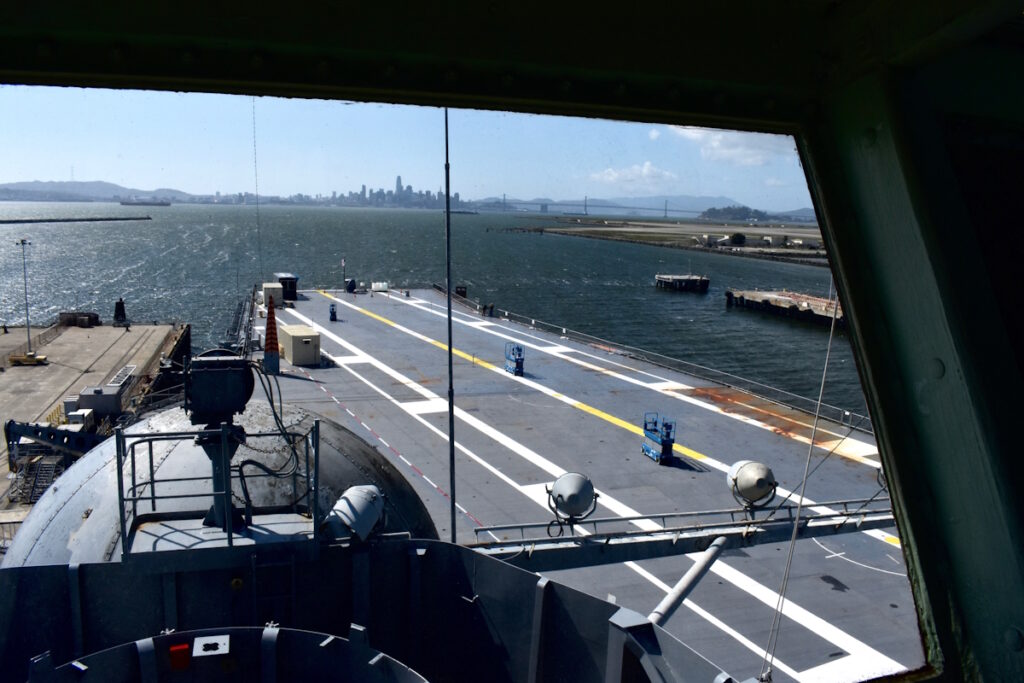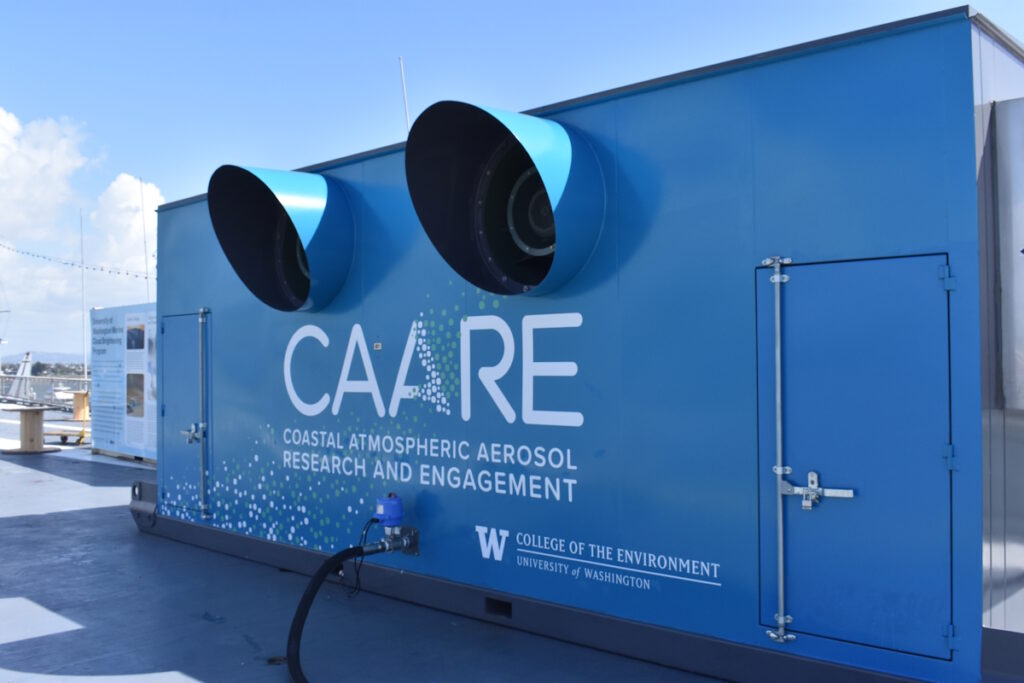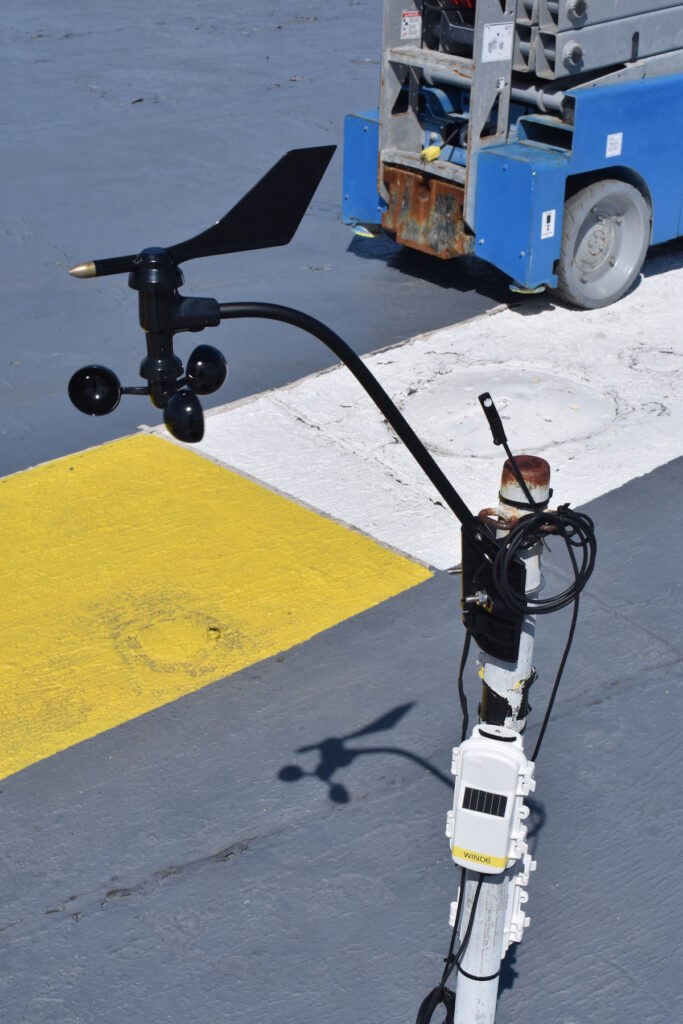HORNET, FABLED SHIP OF PAST, LOOKS TO FUTURE AS IT HOSTS UNIVERSITY OF WASHINGTON “MARINE CLOUD BRIGHTENING PROGRAM”
PART ONE OF THIS STORY

Text and Photos By Larry Freeman ( outsourced photos noted in captions)
The USS Hornet, Alameda’s famed warship museum which commemorates and preserves the past through its ties to the history of critical missions from World War II to Vietnam, and later the recovery vessel for the Apollo 11 Astronauts and capsule, now has a mission that may take it, and possibly all of human kind, into a brighter future.
The Hornet is now host to a visionary experiment that may be of help in offsetting the increasingly damaging effects of global warming, in this case, the warming of earth’s oceans.
In the broadest sense, the Marine Cloud Brightening Program (MCB) seeks to determine if it is possible to “enhance,” using the term of MCB Co -Lead Researcher , Dr. Sarah Doherty, the ability of marine clouds to reflect ocean warming sunlight back up into the atmosphere to create localized cooling. That, in turn, could possibly reduce water temperatures below, notably in areas of great need such as those in arctic regions where indigenous peoples find their ice melting, or at Australia’s Great Barrier Reef where coral and marine life ecosystems are threatened by heating.
The dynamic at issue, known as “marine cloud reflectivity,” involves the upper surface of the cloud acting like a sunlight repellant , something we commonly notice when flying in a plane that rises above the cloud deck below. We see how clouds look almost snow white and bright, due to their upwardly reflected sunlight, even as they may be a deep gray or near black on their ground facing surface.
The notion that it might be possible to harness cloud reflectivity to reduce heat absorption below stems from earlier observations by climate scientist John Latham in 1990.
His son asked, on a hike with him, why clouds look darker at the bottom and lighter at the top. Dad explained that the clouds acted like a mirror to reflect some of the sun’s rays back upward, giving rise to the term “cloud reflectivity, ” and the question as to whether or not clouds could be modified to do more of that in areas where they could have a localized cooling effect, sparked a number of studies into the area that continue to this day, case in point, on the Hornet.
The vessel’s flight deck has been transformed into an open air laboratory as part of the Hornet’s collaboration with a visionary science project, the Marine Cloud Brightening Project (MCB) being run by climate scientists of The University Of Washington and Stanford Research Institute International (SRI).
The experiment involves generating a plume of salt infused water vapor over 200 meters or so of the flight deck through a giant fan like device resembling a snow maker or giant hair dryer to measure what the microscopic particles of salt do when they hit a tiny area of the atmosphere.
The salt particles themselves are even more miniscule — in fact, microscopic in size said Doherty in an exclusive, in depth interview with ANN.
NOW YOU SEE IT, BUT NOW YOU DON’T REALLY
“The particles are so tiny, they don’t have any substantial mass, so that the generated air from the Cloud Aerosol Research Instrument (CARI)” that makes the swirling plume of water vapor on the flight deck.
“The air is less salty than what you get at the beach on a day with breaking waves, ” she said.
So minute are the salt particles, invisible to the naked eye when mixed with the water before vaporizing, that they are measured in nanometers (nm). The dry salt particles mixed in to create the saline water used in the plume are between 50 and 100 nanometers in diameter.
By comparison that ‘good old salt air’ that we take in while soaking up rays on the seaside sand, or while plying over SF Bay or out at sea on a sail boat or other vessel, ranges from 200 nm all the way up to 10,000 nm.
As another measure of comparison, a human hair is approximately 80,000- 100,000 nanometers wide, hence the concentration of salt contained in the plume is anywhere from 1/1000th to 1/700th the size of a strand of hair.

The key focus of the project is to determine what happens to the vaporized salt particles when they hit the outside air in this teeny bit of the local atmosphere.
“We are studying simply how these little sea salt particles that we’re generating get transported in the atmosphere.
When you can visibly see the sea salt plume that we’re making, you can see that the air is really swirly (which affects) how those sea salt particles evolve.
They want to determine “whether they bump into each other, combine to a larger size, how they spread out and how they get affected as they transport towards clouds,” said Doherty.
“We are not brightening clouds, we’re not changing weather, we’re not changing climate.”
Sarah Doherty, Co-Lead Scientist For MCB Project
What they are not doing, she underscored, especially given the major amounts of mass media coverage of the experiment by the likes of The New York Times, The SF Chronicle, KCBS radio, NBC Bay Area TV, and The Smithsonian Magazine, to name a few, is doing anything beyond the deck of the Hornet.
“We are not brightening clouds, we’re not changing weather, we’re not changing climate.
We need some understanding of what’s happening on a small scale in the atmosphere, a really, really small, localized scale,” she said.
In other words, what is going on at The Hornet is like the first baby step in what could be a much more extensive journey if the experiment produces data that point to success.
“We’re hoping to learn whether the particle size changes very much after the first tens of meters, whether our computer models can actually accurately simulate the turbulence in the air that affects the spread of the plume and the concentration at different distances and whether or not that turbulence ends up changing the particle size, and how much all of that depends on the weather conditions,“ added Doherty.
THE PRIMARY PURPOSE OF THE EXPERIMENT: HORNET HELPS LAUNCH A ‘MODELING’ CAREER
But even that is only a small step towards the primary, and rarely reported, more important aspect of the mission on board The Hornet.
And it’s not a secret, no matter what the suggestive, inaccurate, teaser headline said in a recent Smithsonian Magazine article from April 10th that began with “A Secretive Experiment Released Salt Crystals Over San Francisco Bay.”
Ultimately the experiment, which is quite public and literally out in the open, has no hidden nefarious aspect to it. The only part of the experiment that is invisible are the microscopic salt particles released for short term infrequent five to fifteen minute sessions on a few, select mornings when the weather is right.
The program aboard the Hornet ultimately comes down to the ship participating in a modeling debut of sorts.
“We are wanting to better understand how the aerosol evolves so we can improve our computer models,” said Doherty.
If the research ever avails results that suggest that MCB can be done on a larger scale, accurate computer models to run testing before any large scale deployment of cloud enhancement could ever take place.
As MCB scientists collect air measurement data they are also running simulations whereby they “turn on computer model and tell it what were the winds doing that day, what were the temperatures, what was the humidity” and how many droplets come out of the instrument.
The computer uses that data to calculate how the plume spreads, how does the particle size change, what is the concentration at different locations “and then we can compare what the model determines to compare to our observations,” said Doherty.
“ If it knows the conditions, it can try and calculate what it’s all about.
So we can predict better what the sea salt aerosols will be like when they get to clouds if we were to ever scale up the number of particles that we are generating and go out over the ocean and do scientific studies of how a small area of clouds is changed with the addition of particles,” she said.
A WORLD OF UNCERTAINTIES LIES AHEAD
If ever a more grand phase as that takes place, much work would still have to continue.
“The goal of that then would be how to improve our computer models. We would need that to understand how clouds were brightened or not brightened under different conditions and use that to estimate how much climate cooling could be produced by marine cloud brightening and how that cooling would play out in the climate system for temperature changes and precipitation changes so people can make decisions as to whether or not this is something they would ever want to use in the future when we are looking at one or two degrees of climate warming.”
That “if” is a massive one, in stark contrast to the nanoscopic purpose at hand.
PLEASE READ PART II OF THIS STORY SOON
BREAKING NEWS: BUT ANOTHER UNKOWN HAS ARISEN WITHIN THE RANKS OF CITY HALL; PROJECT ON PAUSE FOR NOW
At best, the big unknown in the project has nothing to do with a smaller unknown arising from local concerns of some folks in Alameda, including at least one member of the City Council. All of them were invited to attend an informational meeting with top project scientists, The Dean of UW’s College Of The Environment Maya Tolsoty, and a dozen or so members of The Coastal Atmospheric Aerosol Research And Engagement (CAARE) organization invited to an informational session and tour on board the Hornet on Wednesday April 24.
Only one council member, Trish Spencer, attended the informational event.
She had earlier shared that she had recieved a number of constituent concerns about the study including an email from someone referring to worries about any the physical harm that might be associated with breathing in harmful pollutants. The comminque referenced asbestos particles or other toxins with respect to the salt air the experiment produces.
The only two ingredients used in the experiment, according to the MCB Program’s other Co-Lead, Dr. Robert Wood, are pure water and salt with no additives of any kind. Even basic table salt is not suitable for use in MCB experiment as it is adulterated with other additives. He added that the aerosol emanating from the vaporizing device dissipates rapidly and does not infuse or remain in the air past the immediate vicinity of the ship.
The deck of the Hornet supports the observation that it results in no significant pollution impact as it shows not even a trace of residue as dried salt crystal accumulations or anything else.
Russell Moore, The Hornet’s Community Outreach Manager noted that the Hornet is not impacted by the salt air generated by MCB but that it does have to contend with the much more potent and corrosive forces of mother nature, sea salt laden air, winds, rain, sun and so on. “We have to fight rust on a daily basis,” he said.
Spencer said earlier that she had generalized concerns about potential harm to humans. “We want to know what we’re breathing,” she said in a brief interview days before the information session on The Hornet, mentioning that she wondered if the salt used was different in nature from natural sea salt and could contain “different chemical compounds.” Presumably, she heard at the information event held by UW and The Coastal Atmospheric Aerosol Research And Engagement (CAARE) organization, that the salt used is more pure and free of other particulates than the salt that naturally infused sea air.
It is noteworthy in that regard that the MCB Project scientists, and many in CAARE, specialize in studying air pollution in clouds and the atmosphere on a global level involving much more than just salt.
Spencer stated some procedural concerns with respect to local regulation or oversight with regards to who, and even what policies the city should enact, if any. She suggested that, perhaps, The MCB Program or Hornet should have to apply for a license to conduct the experiment. She also said that, in her view, “this is not a staff only decision.” alluding to City Council involvement in shaping any policy that could follow.
The City Of Alameda is legally the landlord of The Hornet, so it does have some jurisdictional reach.
Spencer also noted that The Council was not apprised about conversations between the City Manager’s Office and representatives from The Hornet that had been going on for as long as two weeks or more.
City Manager Jennifer Ott has not yet responded to inquiries last week regarding the nature of those conversations or whether or not the city kept Council persons in the loop. City Public Information Officer Sarah Henry has agreed to interview on the matter in coming days.
Vice Mayor Tony Daysog also did not respond to questions on the matter.
Hornet CEO Laura Fies last week said the following regarding talks with The City: “We’ve had a lot of conversations with the City over the past two weeks. The scientists have been providing them with information about the nature of the studies of saltwater spray but the Project also did go through a third-party partner, Farallon Strategies, that reviewed the plan to check that the scale and materials involved kept within regulations.”
For now, The MCB project is on a voluntary pause, pending the outcome of Wednesday’s meeting and possible subsequent considerations by The City Council or City.
Councilperson Spencer was the only City Council member to attend the session, though pre printed name tags for invited guests had Vice Mayor Daysog and Councilperson Vella’s names on them. The City’s Sustainability and Resilience Manager,Danielle Hutchings Mieler attended the event according to Henry. Her Linked In page describes her cites environmentally focused priorities as “updating our Climate Action and Resiliency Plan, expanding public EV charging, transitioning buildings to run on Alameda’s 100% clean electricity, expanding the urban forest, adapting to sea level rise, and seismically retrofitting residential buildings.” ANN is awaiting a response from her as to what her take aways were from the UW/CAARE event.
Only two local media reporters, one from alamedanews.org (ANN) and the other from The San Jose Mercury News covered the event.
SPECIAL PUBLIC SERVICE MESSAGE; Dear Reader : To help support alamedanews.org, a 501C-3 non-profit, please subscribe now.
Your contribution to high quality news journalism, our Free Journalism Education Program for youths (and adults as well,) and our free Community Showcase feature will help us keep the lights on. Please see homepage for more details and options. We will, of course accept donations of any amount. If you are already a subscriber, we thank you deeply.

